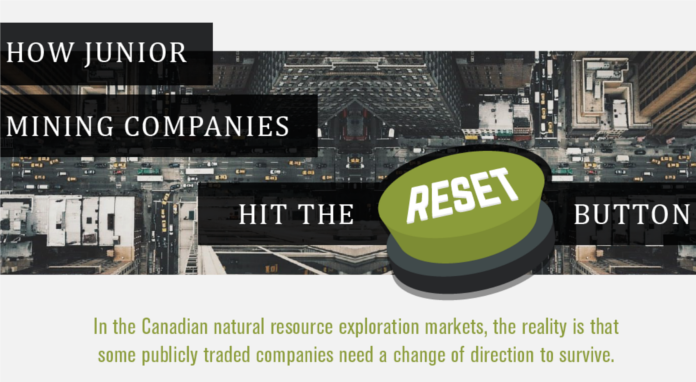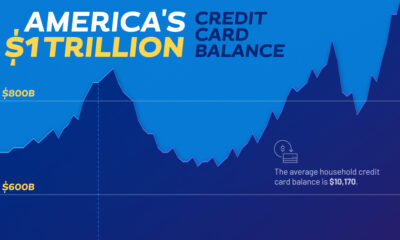Mining
How Junior Mining Companies Hit the Reset Button

How Junior Mining Companies Hit the Reset Button
Special thanks to Dajin Resources for sponsoring.
There is a saying in junior mining that “a rising tide floats all boats”. Basically what this implies is that when the market is doing well, all speculative companies benefit from a booming market at the same time. In other words, an investor can hold a position in any of these companies and receive a payoff.
However, what they don’t tell you is that a falling tide can make it a pretty rocky environment for even many of the best boats and navigators. In this type of environment, many companies can face dire circumstances in which they may need to get creative to survive. This is analogous to our current situation where junior mining stocks have been in a bear market for over four years.
If push comes to shove and a company’s situation becomes troubling enough, one answer is to hit the “reset” button. Management teams that cannot raise money may use this type of solution to rejig their share structure, pay off debt obligations, and eventually reposition their company to raise money again.
How does this work? First, the troubled company would roll back the stock such that multiple shares would be exchanged for one new share (for example, a 6:1 rollback would mean 6 old shares are turned into 1 new share). Note that such a rollback also changes the stock price by the same ratio, so a $0.01 stock would then be trading at $0.06.
Then, the company would issue new stock to settle any debt that is on the books and then raise money again. Ultimately, in order to be successful at any of this, the company needs to also shift their direction in some meaningful way. Changing the management team, switching focuses, or acquiring a new project may be ways to give a company new life.
While it is never fun to admit defeat for management teams or investors, ultimately this “reset” button is something that is a unique part of this sector and for good reason. It gives a clean slate, and creates a share structure and situation which can possibly be turned around.
Lithium
Ranked: The Top 10 EV Battery Manufacturers in 2023
Asia dominates this ranking of the world’s largest EV battery manufacturers in 2023.

The Top 10 EV Battery Manufacturers in 2023
This was originally posted on our Voronoi app. Download the app for free on iOS or Android and discover incredible data-driven charts from a variety of trusted sources.
Despite efforts from the U.S. and EU to secure local domestic supply, all major EV battery manufacturers remain based in Asia.
In this graphic we rank the top 10 EV battery manufacturers by total battery deployment (measured in megawatt-hours) in 2023. The data is from EV Volumes.
Chinese Dominance
Contemporary Amperex Technology Co. Limited (CATL) has swiftly risen in less than a decade to claim the title of the largest global battery group.
The Chinese company now has a 34% share of the market and supplies batteries to a range of made-in-China vehicles, including the Tesla Model Y, SAIC’s MG4/Mulan, and various Li Auto models.
| Company | Country | 2023 Production (megawatt-hour) | Share of Total Production |
|---|---|---|---|
| CATL | 🇨🇳 China | 242,700 | 34% |
| BYD | 🇨🇳 China | 115,917 | 16% |
| LG Energy Solution | 🇰🇷 Korea | 108,487 | 15% |
| Panasonic | 🇯🇵 Japan | 56,560 | 8% |
| SK On | 🇰🇷 Korea | 40,711 | 6% |
| Samsung SDI | 🇰🇷 Korea | 35,703 | 5% |
| CALB | 🇨🇳 China | 23,493 | 3% |
| Farasis Energy | 🇨🇳 China | 16,527 | 2% |
| Envision AESC | 🇨🇳 China | 8,342 | 1% |
| Sunwoda | 🇨🇳 China | 6,979 | 1% |
| Other | - | 56,040 | 8% |
In 2023, BYD surpassed LG Energy Solution to claim second place. This was driven by demand from its own models and growth in third-party deals, including providing batteries for the made-in-Germany Tesla Model Y, Toyota bZ3, Changan UNI-V, Venucia V-Online, as well as several Haval and FAW models.
The top three battery makers (CATL, BYD, LG) collectively account for two-thirds (66%) of total battery deployment.
Once a leader in the EV battery business, Panasonic now holds the fourth position with an 8% market share, down from 9% last year. With its main client, Tesla, now sourcing batteries from multiple suppliers, the Japanese battery maker seems to be losing its competitive edge in the industry.
Overall, the global EV battery market size is projected to grow from $49 billion in 2022 to $98 billion by 2029, according to Fortune Business Insights.
-

 Markets1 week ago
Markets1 week agoU.S. Debt Interest Payments Reach $1 Trillion
-

 Business2 weeks ago
Business2 weeks agoCharted: Big Four Market Share by S&P 500 Audits
-

 Real Estate2 weeks ago
Real Estate2 weeks agoRanked: The Most Valuable Housing Markets in America
-

 Money2 weeks ago
Money2 weeks agoWhich States Have the Highest Minimum Wage in America?
-

 AI2 weeks ago
AI2 weeks agoRanked: Semiconductor Companies by Industry Revenue Share
-

 Markets2 weeks ago
Markets2 weeks agoRanked: The World’s Top Flight Routes, by Revenue
-

 Demographics2 weeks ago
Demographics2 weeks agoPopulation Projections: The World’s 6 Largest Countries in 2075
-

 Markets2 weeks ago
Markets2 weeks agoThe Top 10 States by Real GDP Growth in 2023

















